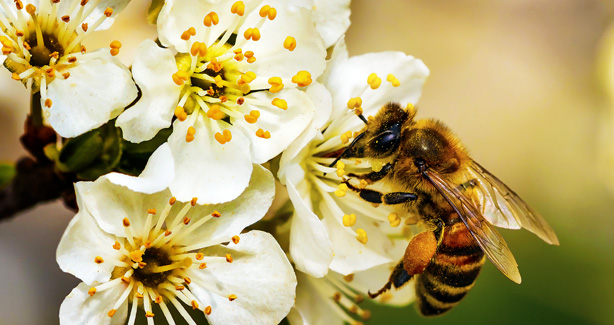 Did you know that about 35% of all the food crops in the world and 75% of all flowering plants depend on pollinators such as bees, butterflies, moths, birds, bats, beetles, and countless other insects to reproduce? Did you know also that that there are more than 3,500 species of native bees that help increase crop yields? In fact one of every three bites of food we eat exists because of pollinators… and our pollinators are in trouble. If they can’t find the right quantity and quality of nectar and pollen from blooming plants within flight range, they won’t survive. Habitat loss, disease, parasites, climate change, and environmental contaminants have all contributed to the decline of many species of pollinators and there are simply no longer enough plants in nature to support all pollinator species. Pollinator-friendly plants also provide year-round and seasonal shelter, nest-building materials, and sometimes even mates for the insects and animals that visit them. Learn more >>
Did you know that about 35% of all the food crops in the world and 75% of all flowering plants depend on pollinators such as bees, butterflies, moths, birds, bats, beetles, and countless other insects to reproduce? Did you know also that that there are more than 3,500 species of native bees that help increase crop yields? In fact one of every three bites of food we eat exists because of pollinators… and our pollinators are in trouble. If they can’t find the right quantity and quality of nectar and pollen from blooming plants within flight range, they won’t survive. Habitat loss, disease, parasites, climate change, and environmental contaminants have all contributed to the decline of many species of pollinators and there are simply no longer enough plants in nature to support all pollinator species. Pollinator-friendly plants also provide year-round and seasonal shelter, nest-building materials, and sometimes even mates for the insects and animals that visit them. Learn more >>
We can all help by planting more native plants!
Plants that are native to our region offer many benefits. These plants attract pollinators necessary for growing vegetable gardens and fruit trees; they often thrive without pesticides and fertilizers, require little water and attention, and improve habitat for wildlife—with the added benefit, of reducing stormwater runoff and improving air quality and biodiversity. DOEE encourages planting a variety of native plants in any garden.
Pollinator gardens come in many forms, but the one aspect that ties them together is using native plants. Flowering plants like asters, sunflowers, wild indigo, goldenrods, phlox, foxglove beardtongue, lobelias, and geranium can provide yellow, white, blue, red, and orange flowers from April to October. Native grasses like bluestem and broomsedge, and ferns like cinnamon fern or lady fern can provide color, height, and texture through the growing season and well into winter. Native shrubs like pinxter azalea, buttonbush, black raspberry, blueberry, winterberry holly, and inkberry, and small trees like persimmon, pawpaw, American holly can provide structure, winter color, and additional habitat (and in some cases, edible fruits). View a list of native pollinator flowers, trees, and shrubs.
It is important to remember that these gardens often do not look like traditional formal landscaped gardens. Your plants may appear tall and weedy until they flower, often late in the summer, but remember they are providing a valuable habitat for bees, butterflies and others. In the fall and winter, DOEE recommends leaving the stalks and dried grass stems in place as they are food and habitat for the egg and larvae of the very pollinators we are trying to attract. This can be unsettling for some neighbors who are more accustomed to traditional landscapes; but don’t let that deter you.
There’s a lot you can do to signal that yours is a pollinator garden. You could put borders or some kind of trim around your garden, you could place a decorative feature in your garden, you could place a sign identifying your garden as a pollinator. Also, keep an eye out for pesky invasives. You will want to pull those out before they have a chance to take hold in your garden and choke out your beneficial plants (View a list of invasive pollinator plants). Lastly, talk to your neighbors about the benefits of your garden. Take and post pictures of your garden and the butterflies and other critters that visit and tag #DOEE_DC on social media. You can also send them to [email protected] and DOEE might share them.
Happy Gardening!
For more information please email [email protected].
Additional Information on Pollinator Planting and Backyard Habitat
- DOEE Pollinator Protection Plan
- View a list of vendors that carry pollinator plants and native species. Or email [email protected] to have your business added to the list.
- Start a Homegrown National Park
- Million Pollinator Garden Challenge
- Selecting Plants for Pollinators
- Learn how to help local bee populations
- Create Habitat for Monarchs
- Learn how to help Monarchs
- Chesapeake Conservation Landscaping Council
- Audubon At Home
- National Wildlife Federation - Garden for Wildlife
- Trees in the District

